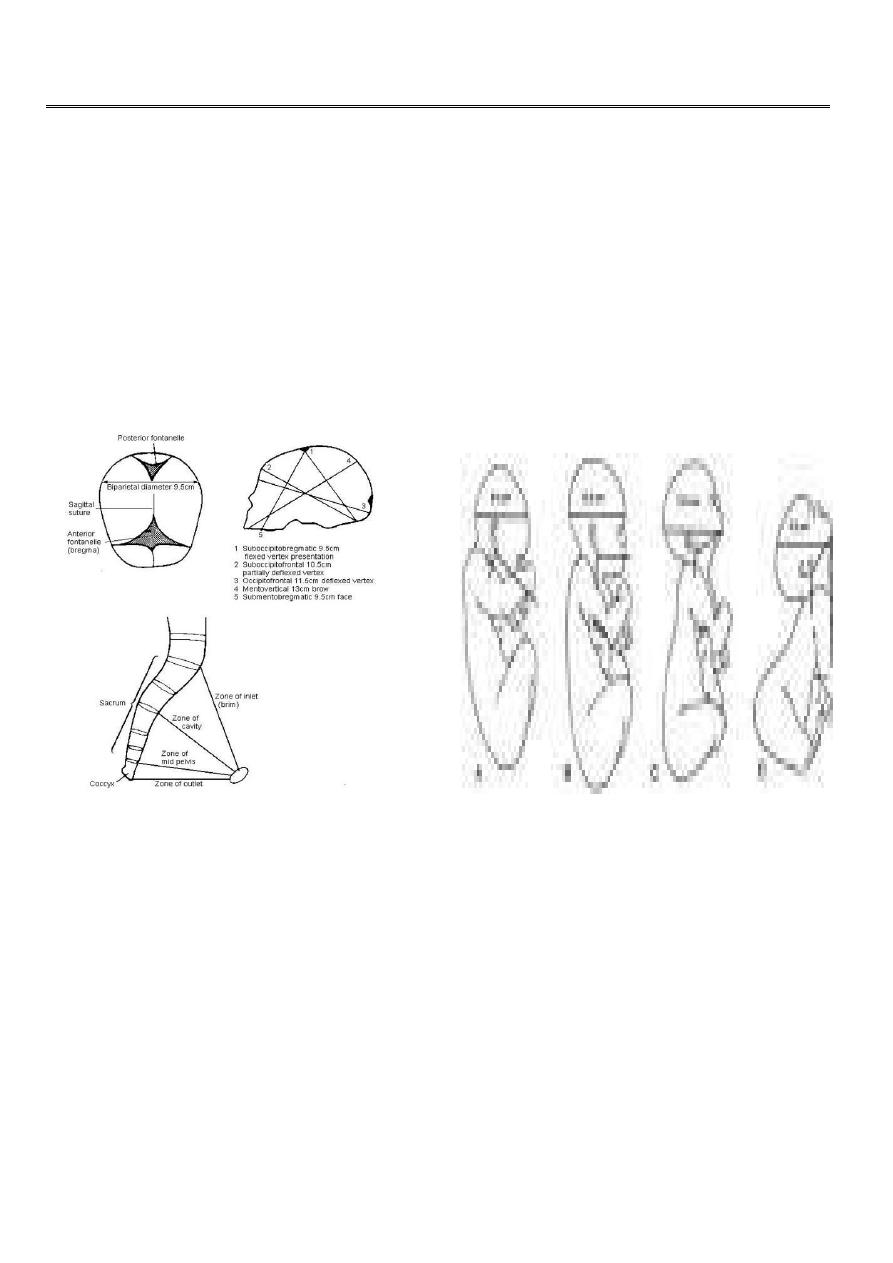
Forth stage
obstetrics
Lec-1
د. أسماء
4/10/2015
Malposition of Fetus
Vertex;
The area of the skull between the anterior and posterior fontanelles, and the
parietal eminence Top of the skull
Occiput
;
Back of the fetal head behind the posterior fontanelle
Sinciput;
That part of the fetal head in front of the anterior fontanelle.-forehead or brow
Malposition:
Position: The relationship of a defined area on the presenting part (Denominator) to the
mother’s pelvis .
Occiputoposterior Position:
A cephalic presentation of the fetus with its occiput
turned toward the turn right (ROP) or
to Left (LOP) sacroiliac joint of the mother

Diagnosis:
Diagnosis during pregnancy is of no importance, except that OP is a cause of non-
engagement of the head before the onset of labor. Early rupture of the membranes
because of poorly engaged ,poorly flexed head during labor.
Abdominal examination:
Slight flattening of the lower abdomen
Limbs are easily felt anteriorly
Difficult to define the back or to feel the fetal heart.
Slow descend of the head during labor because of wider diameter of the poorly flexed
head.
Vaginal examination:
High presenting part,
Early rupture of the membranes
Easy to feel the anterior fontanelle behind the pubis (poorly flexed head).
Both anterior and posterior fontanelle felt (less poorly flexed head).
Only posterior fontanelle felt posteriorly in well flexed head.
Diagnosis should be made early in labor because it will be difficult later on because of the
formation of caput succedaneum late in labor .This is frequently happened and present
with delay in the second stage. Fingers may be passed above the caput to feel the sutures,
or the free margin of an ear.
US in labor may be of help.
Course of labor in Occiputoposterior position:
70% spontaneous rotation to OA
10% short rotation to OP delivery as face to pubis.
Remainder assisted rotation will be required.
In the great majority of labors in the OP position is the same as in OT or OA, except that the
occiput has to rotate through 135 degrees, instead of 90 and 45 degrees respectively .This
occurs if there is:
Effective uterine contraction.
Adequate flexion of the head.
Average size fetus.

Mechanism of labor in OP:
It depends on the head whether well flexed or incompletely flexed.
The well flexed head
Occiput in advance meeting the resistance of pelvic floor, slides
on the gutter of the levator ani muscule with rotation through 3/8 of circle, reaching
the free space under the pubic arch. Delivery of the head is by extension (as in ROA)
There is no delay in labor as the head enter the pelvis with
The subocciputo bregmatic diameter(9.5)
Delivery as OA after spontaneous rotation
Incompletely flexed head
If there is large head or small pelvis
When the head is pushed during labor the BPD is hindered if the pelvis is small or the
head is large forehead descend more easily than the occiput and enter the pelvis
incompletely.
The larger occiputofrontal diameter (11.5)diameter present to the birth canal.
Neither the occiput nor the sinciput is sufficiently in advance to influence rotation
spontaneously and alternative mechanism is used for rotation and delivery.
Difficult and prolonged labor
No progress of labor without intervention
If there is small head or adequate pelvis the forehead meets the resistance of the pelvic
floor, will rotates (1/8 of circle) to the front of the subpubic area and the occiput to the
hollow of the sacrum. Delivery is by face to pubis, the occiput delivered by flexion about the
nose ,followed by delivery of the forehead and the face and chin. Large occiputofrontal
diameter may result into wide perineal tear
Delivered as face to pubis
Incomplete forward rotation from occiputoposterior position with arrest of the head in the
occiputo transverse position described as deep transverse arrest of the head and calls for
assistance.
Assisted delivery to OT
Management of the first stage of labour
Nothing should be done to affect rotation of the head during the first stage of labour.
Management is like normal labor with monitoring of the contraction, dilatation, fetal heart
rate. Continuous epidural pain relief, allow time for spontaneous rotation.
Augmentation of contraction. C.S. is indicated in case of no progress of first stage for few
hours ,or fetal distress.
Management of the 2nd stage of labor
Careful vaginal examination to diagnose the second stage (rectal discomfort with desire to
bear down) Finding suggest that spontaneous rotation may not occur like deflexion . large

caput succedaneum. moulding . Indication for interference are: failure of descend -fetal
distress -maternal distress
Assisting delivery in OP:
Assistance is by rotation of the head to OA to present a smaller more favorable diameter to
the birth canal. Rotation can be performed: -manual rotation and forceps deliver-kjelland’s
forceps -vacuum extractor.
Arrest at the pelvic outlet:
When the fetal scalp is easily visible at the vulval out let. further progress is prevented by
the muscles of the pelvic floor . Adequate episiotomy. Careful traction of the head by
obstetric forceps in OP,or by vaccum.
Trial of forceps
In case of large head with 2/5 palpable with marked caput &moulding. Outlet contraction
(prominent ischial spines). Head is not descend with contraction. Trial of forceps in the
operating theater with scrubbed staff and ready for C.S. if there is : -difficulty in applying
the blades -to much force needed to deliver the baby We should resort to C.S. without
delay and Without risk to the mother and the baby.
Occipito transverse position OT
In which the head enter the pelvis in the occipitotransverse position. Subsequently will
rotate to: ociipito –anterior position in majority of cases. Occipitoposterior position in
minority of cases. In a small percent of cases,the head fails to rotate and persist in an OT
Rotation occurs because the head flexes as the leading part of vertex meets the resistance
of the pelvic floor and then rotates to adjust to the shape of the gynaecoid pelvis
Causes:
Cephalopelvis disproportion.
Platypelloid or android pelvis.
Relaxed pelvic floor due to multiparity and epidural anasthesia.
Diagnosis
:
Easy early labour may be difficult when labour is obstructed.(moulding ,caput)
Deep transverse arrest of the head: describe arrest of descend of the head for a
period of 1 hour .
Arrest occurs because of deflexion that accompanies the persistant OT resulting in
the larger occipitofrontal diameter(11cm)becoming the presenting diameter.
Commonly occurs with the vertex at the +1,+2 station.
Management:
During second stage :
Midpelvis is compromised =C.S.
Normal pelvis+ average size pelvis+inadequate uterine contraction =oxytocine
stimulation of labour.
Manual rotation,forceps delivery with kielland’s forceps if normal pelvis ,average size
baby and the head at +1,+2 station (head occupy the hallow of the sacrum.)
A.L.Y
